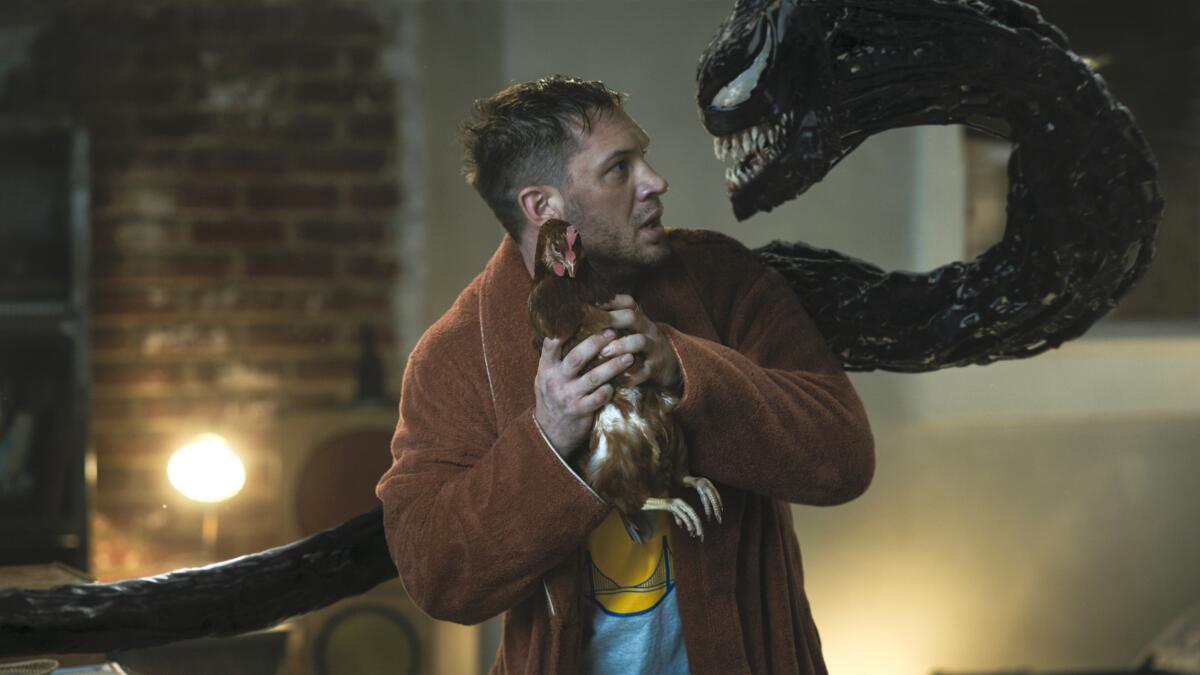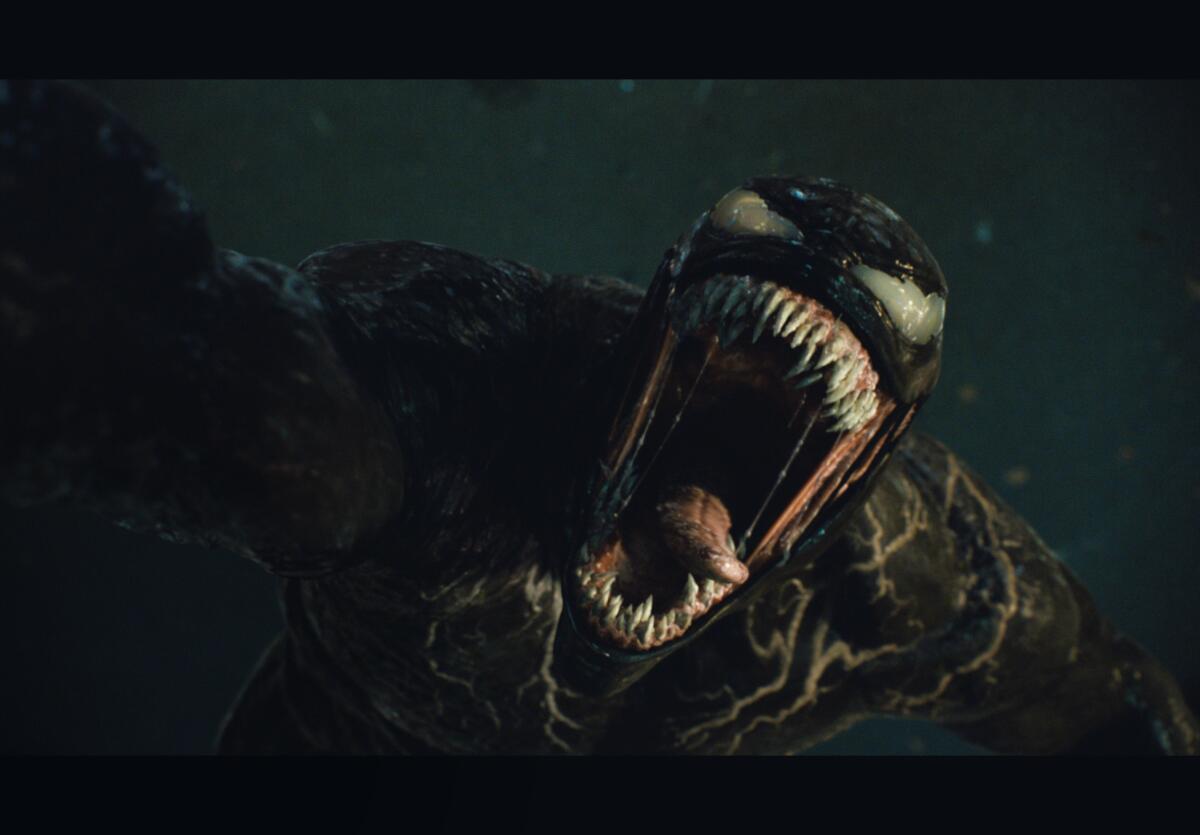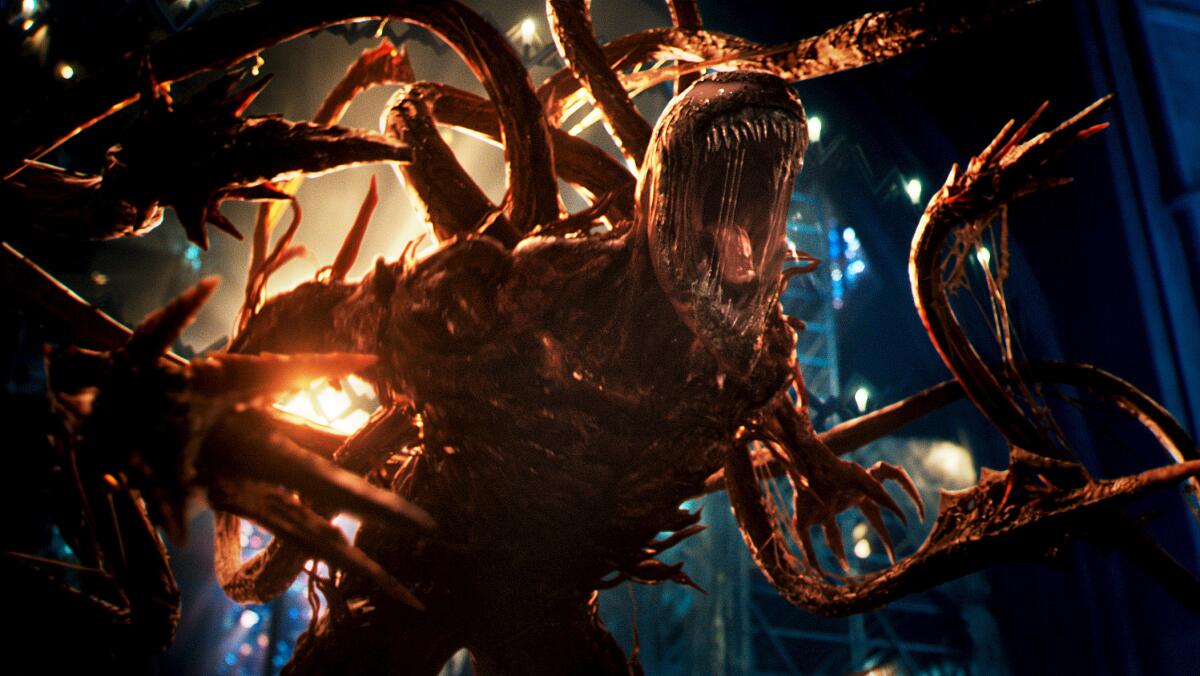Review: ‘Venom: Let There Be Carnage’ works best as a relationship movie. Seriously

The Times is committed to reviewing theatrical film releases during the COVID-19 pandemic. Because moviegoing carries risks during this time, we remind readers to follow health and safety guidelines as outlined by the Centers for Disease Control and Prevention and local health officials.
When Venom, the slimy, villainous parasitic symbiote from outer space swung across movie screens in 2018, both he and his bonded host Eddie Brock (a stirring Tom Hardy) weren’t initially taken seriously. Not that they wanted to be.
The critical consensus to the foul-mouth, brain-eating monster origin story amounted to widespread pans. But for many, “Venom” struck a chord. It gave comic fans some of the silly banter they loved in “Deadpool” and subconsciously spoke to queer moviegoers who shipped “Symbrock,” the fan name for Venom and Brock’s queer-coded relationship, with affecting grace.
In the batty, deeply felt sequel “Venom: Let There Be Carnage,” director Andy Serkis, who helped imbue warring primates with real empathy as the star of the “Planet of the Apes” trilogy, takes over telling the story of another misunderstood creature.
The key difference this time around is the addition of a second villain. The film opens in 1996 with a teenage Cletus Kasady (Jack Bandeira) sitting in a cell in St. Estes Orphanage, sending covert messages through a pipe to his love, Frances Barrison (Olumide Olorunfemi), occupying an adjacent cell. Frances, known in comics as Shriek, has a special, deadly power: Her voice is loud enough to crush the objects around her. The government ultimately hauls her away from Cletus, and she loses an eye after a young cop shoots her.

The distressing opening showcases how Hardy (who has a story credit in addition to starring) and screenwriter Kelly Marcel effectively craft well-built characters in this brisk, 97-minute sequel. Flash forward to the present day, and Cletus (Woody Harrelson) is now on death row. Demented and cheeky, he’s endured years of abuse, ultimately leading him to kill his relatives and murdering even more along the way.
He personally requests a meeting with Brock, believing the journalist can get his message — an incognito haiku addressed to Frances, now imprisoned in a secret government facility — printed on the front page in return for his life story. Cletus is both a terrifying character and yet still somewhat sympathetic: The system let him down.
Brock isn’t doing much better: His ex-girlfriend Anne (Michelle Williams) knows that with Venom in the fold there can never be room for her, and decides to marry her boyfriend Dan (Reid Scott), crushing Brock. As Anne and Dan’s relationship grows richer, both Williams and Scott take big performative breaths with the added dramatic oxygen. Their ping-pong banter with a hilarious Mrs. Chen (Peggy Lu) demonstrates a winning rapport.
“Let There Be Carnage” thrives as a couples movie: Not only do Dan and Anne fortify their mutual love, Brock and Venom deal with their own lovers’ squabbles. No, the pair aren’t officially in a romantic relationship. But this movie is very aware of the queer subtext written into “Venom” — sometimes too aware in bits of on-the-nose dialogue.
Serkis gives “Symbrock” fans what they want by bringing that subtext plainly to the surface. See, Brock blames Venom for his breakup with Anne. It’s also getting more difficult to control the violent symbiote: He needs brains to feed on, and the substitutes — chocolate and live chickens — aren’t enough to satiate his hunger. Especially since he refuses to eat their flatmates, two hens Venom has affectionately named Sonny and Cher.
For a time, Serkis allows this sequel to work as a breakup film. Despite Venom trying his best — he makes breakfast for Brock; couple goals, really — the pair fight. Their domestic squabble is one of the better shot showdowns in “Let There Be Carnage.” The insults they hurl toward each other are tightly layered on a sonic level. The compositions, a parade of fists and thrown objects — Venom launches a big-screen television out the window — are stitched together with clarity through Maryann Brandon and Stan Salfas’ taut editing. This fight isn’t a big exploding comic book-style firework show. It’s a disagreement grounded in a real toxic relationship, and that groundedness consistently allows “Let There Be Carnage” to flourish.

After Brock betrays Cletus, the enraged killer bites Brock’s hand, gaining his own symbiote, a bloodthirsty, uncontrollable alien he names Carnage. The pair decide to do four things: Spring Cletus’ girlfriend Frances (played as an adult by a gloriously demented Naomie Harris), kidnap Anne, kidnap Det. Patrick Mulligan (Stephen Graham), and kill Venom/Brock.
While the narrative is enjoyable, the visuals in “Let There Be Carnage” are as inky as Venom. It’s nearly impossible to follow any of the fight sequences. Cletus’ escape from prison, for instance, is a swirling mess of CGI junk. If you squint hard enough, maybe you can spot Carnage’s red jagged symbiote arm slashing humans to death. But more likely, the serrated frames will feel like a disappointing appetizer in place of a filling main course. It’s a major flaw in an altogether enjoyable picture that’s so off-the-wall it features a heartbroken Venom delivering a pro-immigration speech at a costume party rave.
Whatever shortcomings the brawls have, it’s the human element, ironically in a film filled with parasitic space aliens, that captures the heart. Even in their brief scenes together, Harrelson and Harris possess tangible chemistry, a sultry bond fused by their enrapturing glances. Meanwhile, Cletus and Carnage aren’t so close. Unlike Brock, who offers guardrails to Venom, Cletus and Carnage enable their worst impulses, demonstrating the ways relationships can thrive and fail.
Brock and Venom ultimately do make up, teaming to fight the far more powerful Carnage in a large-scale battle through a San Francisco cathedral. The culminating tussle causes massive damage on screen, but it’s the heavy CGI that truly eviscerates whatever drama might be had.
Still, even when comic book fans inevitably go wild for a game-changing mid-credits scene, it’s not the promised spectacle that cements “Venom: Let There Be Carnage” as touching, wild entertainment. It’s the themes of home, love, and companionship that make Serkis’ sequel another reason to want more “Venom” movies, and quickly.
'Venom: Let There Be Carnage'
Rating: PG-13, for intense sequences of violence and action, some strong language, disturbing material and suggestive references
Running time: 1 hour, 37 minutes
Playing: In general release
More to Read
Only good movies
Get the Indie Focus newsletter, Mark Olsen's weekly guide to the world of cinema.
You may occasionally receive promotional content from the Los Angeles Times.









